全英文初中英语说课稿
初中英语全英说课稿优秀8篇
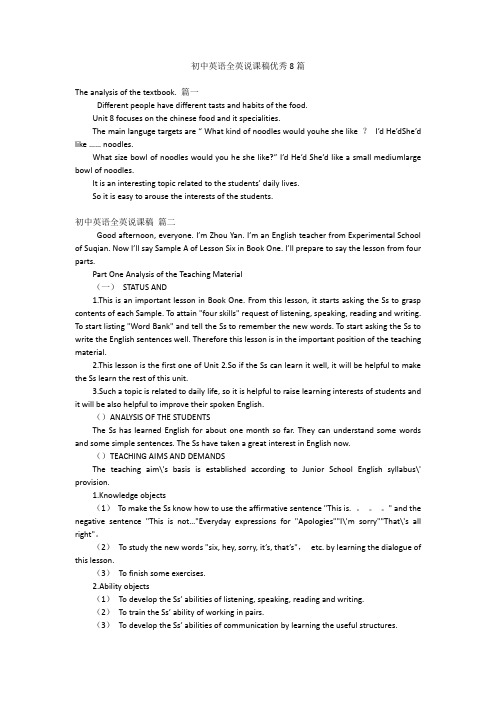
初中英语全英说课稿优秀8篇The analysis of the textbook. 篇一Different people have different tasts and habits of the food.Unit 8 focuses on the chinese food and it specialities.The main languge targets are “ What kind of noodles would youhe she like ?I’d He’dShe’d like …… noodles.What size bowl of noodles would you he she like?” I’d He’d She’d like a small mediumlarge bowl of noodles.It is an interesting topic related to the students’ daily lives.So it is easy to arouse the interests of the students.初中英语全英说课稿篇二Good afternoon, everyone. I’m Zhou Yan. I’m an English teacher from Experimental School of Suqian. Now I’ll say Sample A of Lesson Six in Book One. I’ll prepare to say the lesson from four parts.Part One Analysis of the Teaching Material(一)STATUS AND1.This is an important lesson in Book One. From this lesson, it starts asking the Ss to grasp contents of each Sample. To attain "four skills" request of listening, speaking, reading and writing. To start listing "Word Bank" and tell the Ss to remember the new words. To start asking the Ss to write the English sentences well. Therefore this lesson is in the important position of the teaching material.2.This lesson is the first one of Unit 2.So if the Ss can learn it well, it will be helpful to make the Ss learn the rest of this unit.3.Such a topic is related to daily life, so it is helpful to raise learning interests of students and it will be also helpful to improve their spoken English.()ANALYSIS OF THE STUDENTSThe Ss has learned English for about one month so far. They can understand some words and some simple sentences. The Ss have taken a great interest in English now.()TEACHING AIMS AND DEMANDSThe teaching aim\'s basis is established according to Junior School English syllabus\' provision.1.Knowledge objects(1)To make the Ss know how to use the affirmative sentence "This is. 。
初中英语阅读全英说课稿
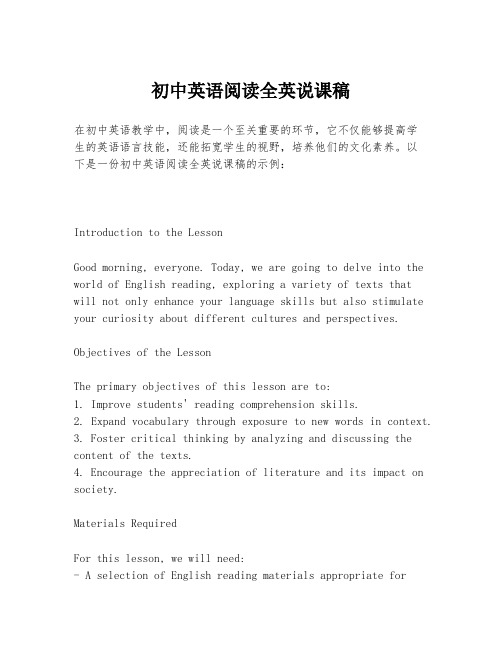
初中英语阅读全英说课稿在初中英语教学中,阅读是一个至关重要的环节,它不仅能够提高学生的英语语言技能,还能拓宽学生的视野,培养他们的文化素养。
以下是一份初中英语阅读全英说课稿的示例:Introduction to the LessonGood morning, everyone. Today, we are going to delve into the world of English reading, exploring a variety of texts thatwill not only enhance your language skills but also stimulate your curiosity about different cultures and perspectives.Objectives of the LessonThe primary objectives of this lesson are to:1. Improve students' reading comprehension skills.2. Expand vocabulary through exposure to new words in context.3. Foster critical thinking by analyzing and discussing the content of the texts.4. Encourage the appreciation of literature and its impact on society.Materials RequiredFor this lesson, we will need:- A selection of English reading materials appropriate forthe level of the students, which may include short stories, articles, and poems.- Handouts with comprehension questions and vocabulary exercises.- A whiteboard and markers for note-taking and discussion.Teaching Procedures1. Warm-up Activity (5 minutes)Begin the class with a quick vocabulary review game. Students will match new words to their definitions, setting the stage for the new vocabulary they will encounter in the reading.2. Introduction to the Text (10 minutes)Briefly introduce the text to be read, providing background information about the author and the context in which the text was written.3. Guided Reading (20 minutes)Students will read the text silently, following along with the teacher who will guide them through the reading, highlighting key vocabulary and phrases.4. Comprehension Check (15 minutes)After reading, conduct a comprehension check using the handouts provided. This will help assess students' understanding of the main ideas and details of the text.5. Vocabulary Expansion (10 minutes)Discuss new vocabulary words in the context of the text.Encourage students to use these words in sentences to reinforce their understanding.6. Group Discussion (15 minutes)Form small groups and have students discuss the themes, characters, and plot of the text. This will promote critical thinking and the ability to express opinions in English.7. Reflection and Feedback (5 minutes)Conclude the lesson by having students reflect on what they have learned and provide feedback on the reading experience.AssessmentStudents will be assessed based on their participation in discussions, the accuracy of their comprehension answers, and their ability to use new vocabulary in context.ConclusionReading in English is a journey of exploration and discovery. By engaging with diverse texts, we not only improve our language proficiency but also enrich our understanding of the world around us. I look forward to our shared journey through the pages of these fascinating texts.This lesson plan is designed to be interactive and student-centered, with a focus on developing both language skills and a deeper appreciation for the art of reading.。
初中英语全英说课稿范文
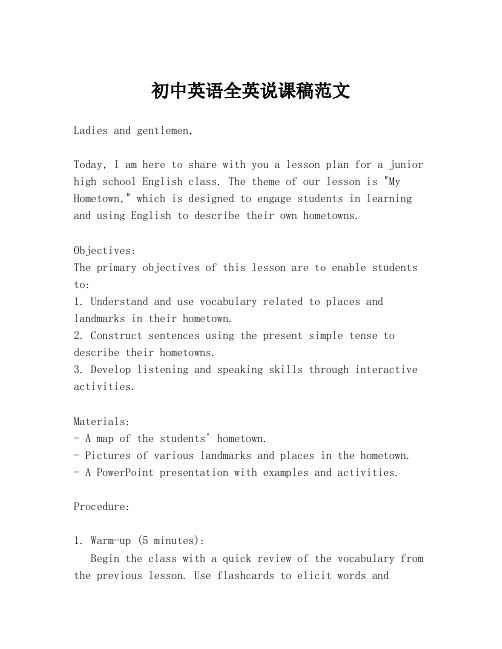
初中英语全英说课稿范文Ladies and gentlemen,Today, I am here to share with you a lesson plan for a junior high school English class. The theme of our lesson is "My Hometown," which is designed to engage students in learning and using English to describe their own hometowns.Objectives:The primary objectives of this lesson are to enable students to:1. Understand and use vocabulary related to places and landmarks in their hometown.2. Construct sentences using the present simple tense to describe their hometowns.3. Develop listening and speaking skills through interactive activities.Materials:- A map of the students' hometown.- Pictures of various landmarks and places in the hometown. - A PowerPoint presentation with examples and activities.Procedure:1. Warm-up (5 minutes):Begin the class with a quick review of the vocabulary from the previous lesson. Use flashcards to elicit words andphrases related to places and landmarks.2. Introduction (10 minutes):Show the students a map of their hometown and ask them to identify different places. Introduce new vocabulary such as "river," "park," "museum," and "historical site."3. Presentation (15 minutes):Use the PowerPoint to present sentences describing various places in a typical hometown. For example, "There is a beautiful park in the center of the city," or "The museum is located near the river."4. Practice (20 minutes):In pairs, students will take turns describing their hometown using the vocabulary and sentence structures introduced. Encourage them to use the present simple tense and to be creative with their descriptions.5. Listening Activity (10 minutes):Play a short audio clip describing a fictional hometown. After listening, students will answer comprehension questions in pairs.6. Group Work (15 minutes):Divide the class into small groups. Each group will create a poster of their hometown, including pictures and descriptions. They will then present their hometown to the class.7. Feedback and Correction (5 minutes):As the groups present, provide feedback on their use of language and encourage the class to correct any mistakes they notice.8. Wrap-up (5 minutes):Conclude the lesson by summarizing the key points and encouraging students to continue practicing their English by describing their hometowns to family and friends.Assessment:Students will be assessed on their participation in class activities, their ability to use the target language accurately, and their contributions to the group project.Differentiation:For advanced students, provide more complex sentences to construct and encourage them to use more sophisticated vocabulary. For struggling students, offer additional support and simpler sentence structures.Reflection:After the lesson, reflect on the effectiveness of the activities and consider any adjustments needed for future lessons to better meet the needs of all students.This concludes the lesson plan for "My Hometown." Thank you for your attention.。
初中英语全英说课稿优秀9篇
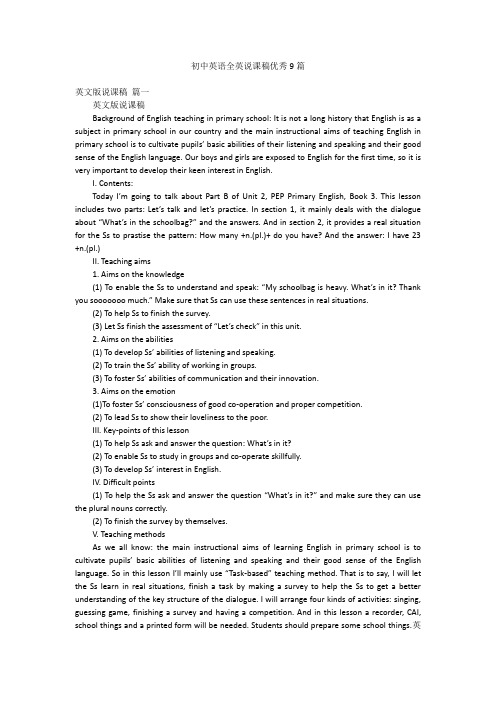
初中英语全英说课稿优秀9篇英文版说课稿篇一英文版说课稿Background of English teaching in primary school: It is not a long history that English is as a subject in primary school in our country and the main instructional aims of teaching English in primary school is to cultivate pupils’ basic abilities of their listening and speaking and their good sense of the English language. Our boys and girls are exposed to English for the first time, so it is very important to develop their keen interest in English.I. Contents:Today I’m going to talk about Part B of Unit 2, PEP Primary English, Book 3. This lesson includes two parts: Let’s talk and let’s practice. In section 1, it mainly deals with the dialogue about “What’s in the schoolbag?” and the answers. And in section 2, it provides a real situation for the Ss to prastise the pattern: How many +n.(pl.)+ do you have? And the answer: I have 23 +n.(pl.)II. Teaching aims1. Aims on the knowledge(1) To enable the Ss to understand and speak: “My schoolbag is heavy. What’s in it? Thank you sooooooo much.” Make sure that Ss can use these sentences in real situations.(2) To help Ss to finish the survey.(3) Let Ss finish the assessment of “Let’s check” in this unit.2. Aims on the abilities(1) To develop Ss’ abilities of listening and speaking.(2) To train the Ss’ ability of working in groups.(3) To foster Ss’ abilities of communication and their innovation.3. Aims on the emotion(1)To foster Ss’ consciousness of good co-operation and proper competition.(2) To lead Ss to show their loveliness to the poor.III. Key-points of this lesson(1) To help Ss ask and answer the question: What’s in it?(2) To enable Ss to study in groups and co-operate skillfully.(3) To develop Ss’ interest in English.IV. Difficult points(1) To help the Ss ask and answer the question “What’s in it?” and make sure they can use the plural nouns correctly.(2) To finish the survey by themselves.V. Teaching methodsAs we all know: the main instructional aims of learning English in primary school is to cultivate pupils’ basic abilities of listening and speaking and their good sense of the English language. So in this lesson I’ll mainly use “Task-based” teaching method. That is to say, I will let the Ss learn in real situations, finish a task by making a survey to help the Ss to get a better understanding of the key structure of the dialogue. I will arrange four kinds of activities: singing, guessing game, finishing a survey and having a competition. And in this lesson a recorder, CAI, school things and a printed form will be needed. Students should prepare some school things.英文版英语说课稿VI. Teaching procedures and purposes of my designing.I’ll finish this lesson in five steps.Step 1. Warm-up and preview1. Free talk between T and Ss about things in the classroom.2. Sing the song together: Books and pencils.3. Do some TPR, for example: Show me your English book. Show me your crayon.4. Review the numbers by asking: “How many crayons do you have?”Purpose: It is important to form a better English learning surrounding for the Ss by singing and doing some total physical response and at the same time it provides situations to review learned knowledge for the next step.Step 2. PresentationNow I’ll mainly talk about this step.1. Present the pattern: “My schoolbag is heavy.” “What’s in it?.”(1) Show a bag and say: “Look! I have a bag.” Carry it and say: “Oh, it is heavy. My schoolbag is heavy.” Help the Ss understand the meaning with the help of my body language. Then lead the Ss to read the sentence. Make sure they can say it correctly.(2) T: My schoolbag is heavy.Open the bag and say: “What’s in it? What’s in my schoolbag?”Take out a Chinese book. Then do the action again. Let the Ss read the sentence.2. Play a guessing game. Divide the whole class into four groups to have a competition.Let them guess: What’s in the bag? How many? Purpose: To present the key structures one by one is much easier for the Ss to learn and grasp the meanings. Proper competition can arouse the Ss’ interest in English learning.3. With the help of the CAI to present the dialogue. Set a situation to help Ss understand: Two Ss are coming. One girl is carrying a heavy bag on her back. They are talking.Girl: My schoolbag is heavy.Boy: What’s in it?Girl: 20 story-books, 32 pencil, 9 rulers, 12 crayons and 30 picture-books. Etc.Boy: What will you do?Girl: They are for the poor.Boy: Great! I’ll bring some school things too.The boy comes back home and puts a lot of things into the bag. Then he goes to school again and gives them to a teacher. While he is taking them out, he is counting the numbers of all things. The teacher says: Thank you soooooooo much.4. Mention that we should take care of the poor.5. Play the cassette. Let the Ss listen and imitate the dialogue.Pay attention to their pronunciation and intonation. Purpose: CAI can provide a real situation for the Ss to understand the dialogue and the relationships between people better. Tell the Ss we should show our loveliness to the Ss.Step 3. PracticeDivide Ss into groups of six children. Each one would finish the printed form by asking and answering: How many storybooks do you have? Find out which group finishes faster. Story books picture-books sharpeners crayons pencils erasers pencil-cases rulers Chen Jie 8 24 3 32 26 4 1 3Purpose: Task-based teaching method is used here to develop Ss’ ability of communication and also their ability of co-operation will be well trained.Step 4. AssessmentHelp Ss finish “Let’s check” of this unit and workbook.Purpose: To check the knowledge Ss have learned in this period.Step 5. Add-activity1. Let Ss tell each other how many school things they have after class. Tell their parents how many school things they have at home.2. Take care of everything they have.Purpose: Revision is so important that Ss should speak English as much as they as in class or after class. It is necessary for the Ss to do some extensive exercises after class to consolidate the knowledge they learned.英文版英语说课稿初中英语说课稿篇二今天我的说课内容是新目标英语八年级上册第四单元第一课时。
初中英语说课稿范文五篇
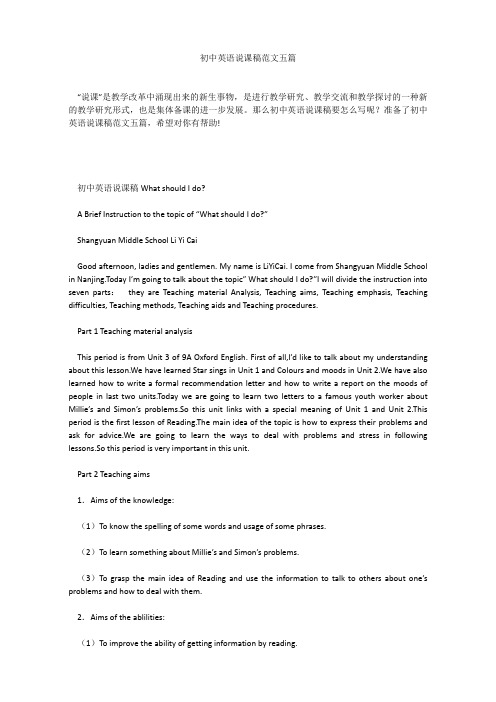
初中英语说课稿范文五篇“说课”是教学改革中涌现出来的新生事物,是进行教学研究、教学交流和教学探讨的一种新的教学研究形式,也是集体备课的进一步发展。
那么初中英语说课稿要怎么写呢?准备了初中英语说课稿范文五篇,希望对你有帮助!初中英语说课稿What should I do?A Brief Instruction to the topic of “What should I do?”Shangyuan Middle School Li Yi CaiGood afternoon, ladies and gentlemen. My name is LiYiCai. I come from Shangyuan Middle School in Nanjing.Today I’m going to talk about the topic” What should I do?”I will divide the instruction into seven parts:they are Teaching material Analysis, Teaching aims, Teaching emphasis, Teaching difficulties, Teaching methods, Teaching aids and Teaching procedures.Part 1 Teaching material analysisThis period is from Unit 3 of 9A Oxford English. First of all,I’d like to talk about my understanding about this lesson.We have learned Star sings in Unit 1 and Colours and moods in Unit 2.We have also learned how to write a formal recommendation letter and how to write a report on the moods of people in last two units.Today we are going to learn two letters to a famous youth worker about Millie’s and Simon’s problems.So this unit links with a special meaning of Unit 1 and Unit 2.This period is the first lesson of Reading.The main idea of the topic is how to express their problems and ask for advice.We are going to learn the ways to deal with problems and stress in following lessons.So this period is very important in this unit.Part 2 Teaching aims1.Aims of the knowledge:(1)To know the spelling of some words and usage of some phrases.(2)To learn something about Millie’s and Simon’s problems.(3)To grasp the main idea of Reading and use the information to talk to others about one’s problems and how to deal with them.2.Aims of the ablilities:(2)To improve the ability of retelling the story.3.Aims of the emotion:(1)To understand how to write about problems and to express feelings.(2)To ask for advice to solve the problems.Part 3 Teaching emphasis1.To master the ‘to’-infinitives and ‘wh-’words+‘to’-infinitives.2.To get the ability of general reading and getting information.Part 4 Teaching difficulties1.To recognize and understand vocabulary about problems.2.To ask for advicePart 5 Teaching methodsIn this topic,I will use five-step Teaching Method and Task-based language Teaching.I design some tasks to help the students learn.I think if I want to improve the students’ oral English,I should give them enough chances to practice and I will use pair work,group work to let the students take an active part in all kinds of activities.That is “Learning by doing,learning by using”.Let the students be the masters of the class teaching,thus,student-centered teaching method is well shown.Part 6 Teaching aidsProjector,slide show,tape recorder and blackboardPart 7 Teaching procedureStep Ⅰ.Lead-inThe purpose is to arouse the students’interest of study.Let’s have a free talk.T:Have you got problems?S:Yes.S:Eating too much makes me unhealthy.T:What about you?S:……Step Ⅰ.PresentationThe purpose is to develop the skills of skimming and how to gain the main idea of the articles. 1.Ask students to read two letters and answer the following questions:①What is Millie’s favorite hobby?(Painting)②What is Millie’s problem?(She doesn’t have enough time for hobbies and home work.)③When does Simon play football?(After school until late)④How do his parents feel about it?(They don’t like this and ask him to go home before 6 p.m.)2.Ask students if there are words that they do not know.Explain some new words briefly.deal;choice;complete;refuse;accept;spare;doubt;whether;Step Ⅰ.PracticeThe purpose is to develop the skills of scanning and how to gain the details from the articles. 1.Listen to the tape and answer some question about “True”or“False”.2.Ask students to read the articles again and explain some important phrases.How to solve the problems;hand in;on time;at the moment;can’t find any time for my hobbies;feel bad;give up;achieve a balance between the two;hear form;make unhappyStep Ⅰ.Retelling1.Ask students to make sentences with phrases that we have learned.2.Try to retell the outline of the articles.3.Encourage students to say something about themselves.Step Ⅰ.Summary and homeworkThe purpose is to give the students a clear idea of how to express their problems and revise the articles.1.Ask students to revise the words and phrases2.Ask students to write a letter about himself after class.During my teaching,I’ll try my best to get my class alive and encourage the students to talk with each other in English. I think the general aim of English teaching is to improve the ability of using English. And I’ll use this to guide my teaching.Thank you!牛津英语9A Unit 3说课稿一、说教材:1、教材简析:我说课的内容是江苏牛津中学英语教材9A第3单元Teenage problems中的Integrated skills 部分。
初中英语全英说课稿(优秀5篇)
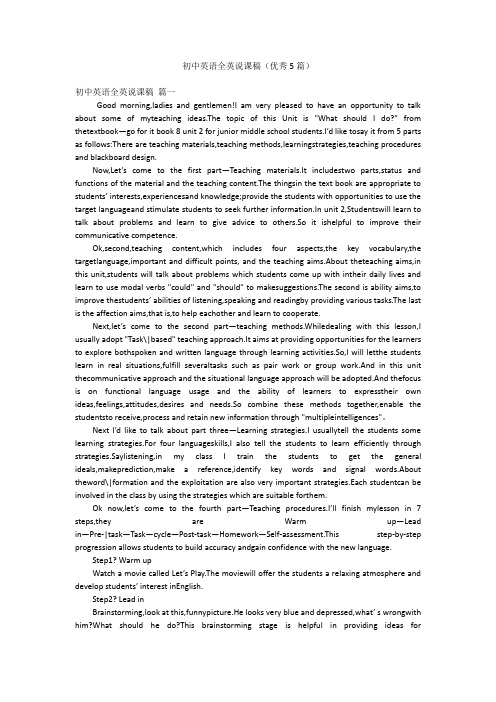
初中英语全英说课稿(优秀5篇)初中英语全英说课稿篇一Good morning,ladies and gentlemen!I am very pleased to have an opportunity to talk about some of myteaching ideas.The topic of this Unit is "What should I do?" from thetextbook—go for it book 8 unit 2 for junior middle school students.I’d like tosay it from 5 parts as follows:There are teaching materials,teaching methods,learningstrategies,teaching procedures and blackboard design.Now,Let’s come to the first part—Teaching materials.It includestwo parts,status and functions of the material and the teaching content.The thingsin the text book are appropriate to students’ interests,experiencesand knowledge;provide the students with opportunities to use the target languageand stimulate students to seek further information.In unit 2,Studentswill learn to talk about problems and learn to give advice to others.So it ishelpful to improve their communicative competence.Ok,second,teaching content,which includes four aspects,the key vocabulary,the targetlanguage,important and difficult points, and the teaching aims.About theteaching aims,in this unit,students will talk about problems which students come up with intheir daily lives and learn to use modal verbs "could" and "should" to makesuggestions.The second is ability aims,to improve thestudents’ abilities of listening,speaking and readingby providing various tasks.The last is the affection aims,that is,to help eachother and learn to cooperate.Next,let’s come to the second part—teaching methods.Whiledealing with this lesson,I usually adopt "Task\|based" teaching approach.It aims at providing opportunities for the learners to explore bothspoken and written language through learning activities.So,I will letthe students learn in real situations,fulfill severaltasks such as pair work or group work.And in this unit thecommunicative approach and the situational language approach will be adopted.And thefocus is on functional language usage and the ability of learners to expresstheir own ideas,feelings,attitudes,desires and needs.So combine these methods together,enable the studentsto receive,process and retain new information through "multipleintelligences"。
初中英语说课稿(优秀6篇)

初中英语说课稿(优秀6篇)初中英语说课稿篇一Cell phone is very popular and used widely recent cell phone,people can,any time,contact friends,talk to families and send blessing SMS to the beloved enjoying so many convineiences,cell phone also has some negative effects on generated by cell phone is harmful to healthy; Specially,ring bells may disturb example,if you are sleeping at noon break in the office,a sudden ring call may shock you from a dream; when all the students are listening to the teacher,a loud ring bell will interrupt the class and make others annoyed; or during a meeting,a call noices is really impolite to other should know where and how to use cell phone properly,and just turn off your phone if it maybe disturbs others.初中英语说课稿篇二Nowadays mobile phones are being more and more popular among the middle school students. Some think it is good for students to bring a mobile phone. But some people do not think so. They think it is bad for students to bring a mobile phone. Because the students will use mobile phones to play games,sent text messages,watch movies,etc which will do harm to their study. And if a mobile phone ring in the class,the teacher and students would be disturbed.In my opinion,we can bring mobile phones to we know,the 21st century is a modern age and full of information. A mobile phone is one of the quickest tools for us to exchange information. The mobile phone is a fashionable and useful invention,so we ought to make the best use of it. Suppose there’s a sudden accident,it is more convenient for us to dial for help immediately. There’re also some games in the mobile phone. We can relax ourselves by playing them when we’re tired of our studies. In my opinion,it’s not wrong to follow the fashion,but the most important thing is how to use the mobile phone in a right way and do not disturbed others.初中英语说课稿篇三In the old China, people were seduced by opium and many people had ruinedtheir lives. Today, China bees stronger and opium has bee the history, butthe new type drug catches people's attention all the time. When we walk aroundthe street, we can find that most people are lowering their heads and playingsmart phone.Smart phone has been the new drug for people, especially for younggeneration. They play it for such a long time that their body health is underthreat. The news has reported many incidents of people feel unfortable afterplaying mobile phones for a long time. We need to use mobile phone in the properway, or we will get into trouble.初中英语说课稿篇四各位评委老师:下午好!一、教材分析1、教材的地位及作用:七年级(下)第三单元,围绕Danny,Jenny,LiMing 和在北京的参观游玩活动为中心,讨论了有关打车,放风筝,照相,给家人写信,发电子邮件,购物的话题。
初中英语说课稿精选全英

初中英语说课稿精选全英Ladies and gentlemen,Today, I am excited to share with you a lesson plan that I have designed for a junior high school English class. This lesson is titled "Exploring the World of English Literature," and it is aimed at enhancing students' appreciation for English literature while improving their language skills.Objectives:1. To introduce students to various genres of English literature.2. To improve students' reading comprehension and vocabulary.3. To encourage students to express their thoughts and opinions in English.Materials:- Copies of selected English literature excerpts.- Whiteboard and markers.- Audio-visual equipment for playing literary adaptations.Warm-up Activity:We will begin the class with a brief discussion about the students' favorite books and authors. This will serve as an icebreaker and help gauge their familiarity with English literature.Introduction:I will introduce the concept of literature and its importance in our lives. We will discuss the different genres, such as poetry, prose, and drama, and their unique characteristics.Reading Comprehension:Students will be divided into small groups and given excerpts from various English literary works. They will read the excerpts silently, followed by a group discussion to answer comprehension questions and share their interpretations.Vocabulary Enhancement:We will identify and discuss new vocabulary words from the excerpts. Students will be encouraged to use these words in sentences to reinforce their understanding.Literary Analysis:Next, we will delve into the analysis of the selected literature. Students will learn about literary devices such as metaphor, simile, and personification, and how they are used in the texts.Creative Writing:To apply their learning, students will be asked to write a short paragraph inspired by one of the literary works they have read. This will help them practice using new vocabulary and literary techniques.Conclusion:We will conclude the lesson by sharing the creative writing pieces with the class. This will provide an opportunity for peer feedback and further discussion.Homework:For homework, students will be asked to choose a piece of English literature that interests them and write a brief summary and analysis, focusing on the use of language and literary devices.Assessment:The lesson will be assessed through group participation, the quality of the creative writing, and the homework assignment.I believe this lesson plan will not only improve students' English language skills but also ignite a passion for English literature. Thank you for your attention, and I look forward to implementing this lesson in the classroom.。
全英文初中英语说课稿范文
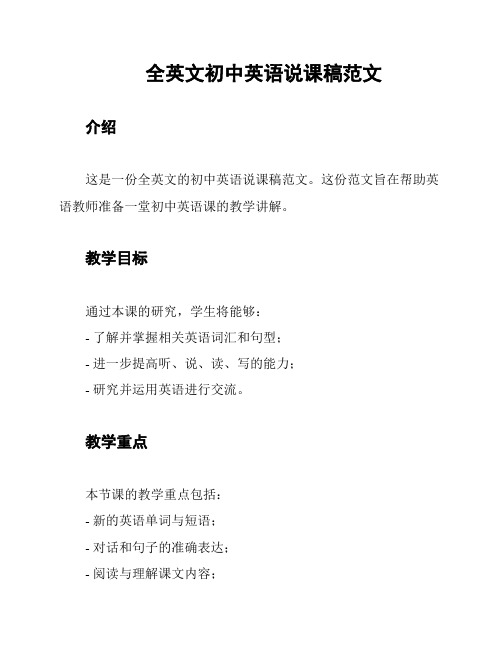
全英文初中英语说课稿范文介绍这是一份全英文的初中英语说课稿范文。
这份范文旨在帮助英语教师准备一堂初中英语课的教学讲解。
教学目标通过本课的研究,学生将能够:- 了解并掌握相关英语词汇和句型;- 进一步提高听、说、读、写的能力;- 研究并运用英语进行交流。
教学重点本节课的教学重点包括:- 新的英语单词与短语;- 对话和句子的准确表达;- 阅读与理解课文内容;- 口语表达和书写能力的提升。
教学准备在开始授课之前,教师需要准备以下教学材料:- PowerPoint幻灯片;- 学生课本和练册;- 黑板和白板擦;- 没有版权问题的相关图片。
教学过程第一阶段:导入 (5分钟)教师通过展示相关图片和用英语与学生进行简单的对话,激发学生的研究兴趣。
第二阶段:新知讲解 (15分钟)教师介绍本节课的新单词和短语,通过示范、解释并提供例句帮助学生理解和记忆。
第三阶段:对话练 (15分钟)教师与学生进行对话练,引导学生熟练运用新单词和短语,并纠正他们的发音和语法错误。
第四阶段:阅读理解 (15分钟)教师让学生阅读一篇相关短文,并提问相关问题,帮助学生理解课文内容并提高阅读理解能力。
第五阶段:口语表达 (15分钟)教师与学生进行口语对话训练,通过角色扮演和实际情境练提高学生的口语表达能力。
第六阶段:练与巩固 (10分钟)教师组织学生进行练和巩固活动,如填空题、选择题等,以检验学生对本节课内容的掌握程度。
第七阶段:作业布置 (5分钟)教师布置适当的课后作业,巩固学生对本节课内容的理解和运用。
教学评价教师可以通过观察学生在课堂上的表现、听写、口语交流等方式对学生的研究情况进行评价。
结束语通过本堂课的研究,相信学生们能够更好地掌握英语知识,提高自己的英语能力。
谢谢大家!以上是全英文初中英语说课稿范文的详细内容,希望对您有所帮助。
全英文初中英语说课稿模板
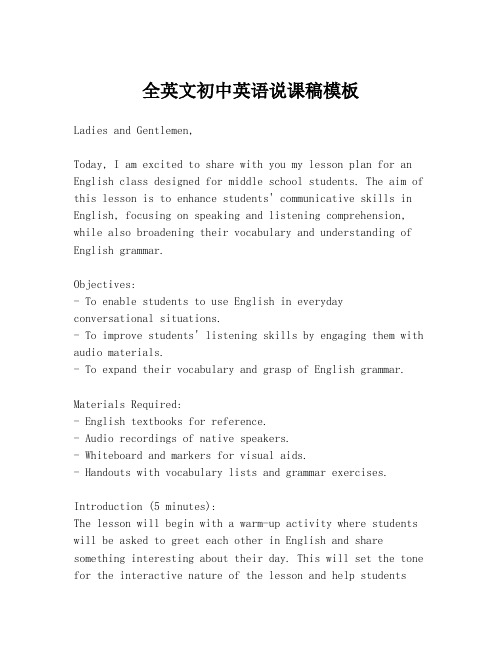
全英文初中英语说课稿模板Ladies and Gentlemen,Today, I am excited to share with you my lesson plan for an English class designed for middle school students. The aim of this lesson is to enhance students' communicative skills in English, focusing on speaking and listening comprehension, while also broadening their vocabulary and understanding of English grammar.Objectives:- To enable students to use English in everyday conversational situations.- To improve students' listening skills by engaging them with audio materials.- To expand their vocabulary and grasp of English grammar.Materials Required:- English textbooks for reference.- Audio recordings of native speakers.- Whiteboard and markers for visual aids.- Handouts with vocabulary lists and grammar exercises.Introduction (5 minutes):The lesson will begin with a warm-up activity where students will be asked to greet each other in English and share something interesting about their day. This will set the tone for the interactive nature of the lesson and help studentsfeel comfortable using English.Vocabulary Building (10 minutes):Next, we will delve into a new set of vocabulary wordsrelated to our topic for the day. I will use flashcards and images to make the learning process more engaging. Students will be encouraged to use these words in sentences to reinforce their understanding.Grammar Focus (15 minutes):After vocabulary building, we will move on to the grammar section. Today's focus will be on the present continuous tense, which is essential for describing actions happening at the moment of speaking. I will provide clear explanations, examples, and conduct drills to ensure students can applythis tense correctly.Listening Practice (15 minutes):Listening to English is crucial for developing an ear for the language. Students will listen to a short audio clip of a conversation between two native speakers. After the listening exercise, we will discuss the content and answer comprehension questions to check their understanding.Speaking Activity (15 minutes):To apply what they have learned, students will participate in a role-play activity. They will be divided into pairs and given a scenario to act out using the new vocabulary and grammar structures. This will allow them to practice speaking English in a fun and supportive environment.Conclusion (5 minutes):The lesson will conclude with a quick review of the day's learning objectives and a summary of the key points. I will also provide feedback on the students' performance during the speaking activity and offer suggestions for further practice.Homework Assignment:As homework, students will be asked to write a short paragraph using the new vocabulary and present continuous tense to describe an ongoing activity they are currently engaged in.I believe this lesson plan will be both educational and enjoyable for the students, providing them with ample opportunities to practice and improve their English skills.Thank you for your attention. I am looking forward to implementing this lesson and seeing the progress of our students.Best regards,[Your Name]。
初中英文说课稿

初中英⽂说课稿初中英⽂说课稿范⽂(精选5篇) 作为⼀名教职⼯,有必要进⾏细致的说课稿准备⼯作,写说课稿能有效帮助我们总结和提升讲课技巧。
写说课稿需要注意哪些格式呢?以下是⼩编整理的初中英⽂说课稿范⽂模板(精选5篇),欢迎阅读,希望⼤家能够喜欢。
初中英⽂说课稿1 ⼀、说教材(教材分析) Analyzing teaching material 1. 说课型 lesson type (Dialogue/ reading/ listening/ revision) 2. 本课在教材中的地位 status and function Lesson 33 Saving the Earth is a dialogue. The lesson is focused on the topic of the problems of the earth and the functional items of Supposition/ Intentions/ conjecture/ Prohibition. Since it is a dialogue / reading. It’s helpful to improve the Ss communicative/ reading ability. 3. 说教学指导思想 teaching guideline (Teaching syllabus: Language is for communication, develop their four skills, lay special emphasis on reading; Grellet put it well in his book developing reading skills: develop reading skill/ discourse analysis; get them to understand the western culture better; improve the ability to discover, analyze & solve the problems; Reading is for information, for fun; Use Top- down model or Bottom- up model to activate Ss schemata; Interactive model) 4. 说教学⽬标和要求 Teaching aims and demands (…be intended for Ss in key schools) 1)认知⽬标 knowledge objects a. Enable the Ss to remember the following new words & phrases: Damage, lecture, pollute, pollution, room, standing room, be fit for, hear about, turn into b. Get the Ss to be familiar with this sentence pattern: If the population keeps growing so quickly, there will only be standing room left… Give the Ss a reinforced practice on the functional item Supposition. c. Activate Ss schemata regarding the topic of pollution and help Ss to know more about the problem of pollution. 2)智能⽬标 ability objects a. Ask the Ss to make up a similar dialogue. b. Help them to understand the dialogue better and improve the four skills. c. Develop their ability of thinking independently. d. Cultivate their ability to discover, analyze and solve problems. e. Train them to collect information from the Internet. f. Train them with some effective learning methods to optimize Ss’ learning results. 3)德育⽬标 moral objects a. Arouse their interest in learning English; b. Help them to understand the background of pollution. c. Enable the students to love our earth and the nature. d. Be aware of the importance of stopping pollution & protecting our environment. e. Encourage the Ss to do something to save the earth. 5. 说教学重点 teaching important points (⽣词、句型;培养阅读技能) a. New words and phrases b. Sentence pattern: If- clause c. improve their reading skills. d. Talking about problems of the Earth. 6. 说教学难点 teaching difficult points (语法;发展交际能⼒) a. functional item: Supposition. b. Develop their communicative ability. Act out their own dialogue. 7. 说教具 teaching aids (multi-media computer, software, OHP) The teaching syllabus says that it’s necessary for teachers to use modern teaching facilities. It’s of great help to increase the class density and improve our teaching result. It can also make the Ss reach a better understanding of the text by making the classes lively and interesting. At the same time, it arouses the Ss’ interest in learning English. ⼆、说教法 Teaching methods Five step method; audio-video; communicative approach; Task-based learning: New Syllabus Design encourages teachers to use this teaching method. TBLT can stimulate Ss’ initiative in learning and develop their ability in language application. Make the Ss the real masters in class while the teacher himself acts as the director and bring their ability into full play. 三、说学法 Study methods 1. Teach Ss how to be successful language learners. 2. Teach Ss how to develop the reading skill — skim & scan; how to communicate with others; how to learn new words; how to learn independently; 3. Get the Ss to form good learning habits. 四、说教学过程Teaching procedures I. 复习(Revision) 5min (Daily report; 词汇diagram; brainstorming; activate schemata) Activity 1: Imagination 1) Suppose a bottle of ink is turned over and dirties your white shirt, what is to be done? (Wash it? Or throw it away?) 2) Suppose you catch a bad cold, what’s to be done? 3) Suppose your bike is broken, what’s to be done? 4) And suppose the earth, on which we all live, is damaged, what’s to be done? * What can you think of when you see "pollution" this word?(waste, environment, air, water, factory, desert, climate…Try to activate the Ss schemata regarding the topic of pollution.) II. 呈现(Presentation) 5min Activity 2: Presentation Play the song "Earth Song" sung by Michael Jackson. (Create an atmosphere) A lot of pictures and video clips about the causes and results of the three problems mentioned in this lesson will be shown on the screen with the help of the computer. Ss’ presentation on pollution. Attract their attention, arouse their interest, and create a good atmosphere for communication. * Activate their schemata and cultivate their ability in collecting information from the Internet and develop their ability in thinking independently. III. 对话 / 阅读(Dialogue)18m 1. Pre- reading Activity 3: Prediction 1st listening/ fast reading, one guided Q to help Ss to get the main idea: What do you think is discussed at the conference? 2. While- reading Activity 4: Read and answer 2nd listening/ careful reading, more Qs to get the detailed information. Develop their reading skills: skim & scan. Pay attention to the pronunciation, stress & intonation. * 阅读: Pre-reading; while-reading; post-reading (fast reading/ careful reading; skim/ scan; 识别关键词key words;确定主题句;创设信息差information gap;T or F; 填表格chart/diagram; Predicting; Make a timeline; Make a story map.达到对课⽂的`整体理解和掌握。
初中英语说课稿全英

初中英语说课稿全英Ladies and Gentlemen,Today, I am here to present a lesson plan for a junior high school English class. The topic of our lesson is "The Importance of Communication Skills". This lesson is designed to be interactive and engaging, aiming to help students understand the significance of effective communication in their daily lives and to develop their English speaking abilities.Objectives:1. To enable students to recognize the importance of communication skills.2. To improve students' English vocabulary related to communication.3. To practice listening and speaking skills through various activities.Materials:- Whiteboard and markers- Handouts with vocabulary and phrases- Audio recording of a conversation- Video clips demonstrating effective communication- Role-play scenariosIntroduction (5 minutes):Begin the class with a thought-provoking question: "Can youimagine a world without communication?" Allow students to share their thoughts briefly to set the context for the lesson.Vocabulary Building (10 minutes):Distribute handouts containing key vocabulary words such as 'articulate', 'persuasive', 'empathetic', and 'non-verbal cues'. Explain the meanings and encourage students to use these words in sentences.Listening Practice (15 minutes):Play an audio recording of a conversation where effective communication is demonstrated. After listening, ask students to identify the communication skills used by the speakers.Speaking Practice (20 minutes):Divide the class into small groups and assign each group a role-play scenario that requires effective communication. For example, negotiating a peace treaty, resolving a conflict, or persuading someone to join a club. Encourage students to use the vocabulary they learned earlier.Video Analysis (10 minutes):Show a video clip of a public speaker or a scene from a movie where communication skills are crucial. Discuss the techniques used by the speaker or characters and how they contribute to the effectiveness of the communication.Debate Activity (15 minutes):Organize a debate on a relevant topic, such as "Is face-to-face communication better than digital communication?". Thiswill allow students to apply their communication skills in a structured setting.Conclusion (5 minutes):Summarize the key points of the lesson and emphasize the importance of communication skills in personal and professional contexts. Encourage students to reflect on how they can improve their own communication abilities.Homework:Ask students to write a short essay on the role of communication in their lives, using the vocabulary and concepts covered in the lesson.This lesson plan is designed to be dynamic and student-centered, ensuring that students not only understand the theoretical aspects of communication but also have the opportunity to practice and apply these skills in a variety of contexts. Thank you for your attention.。
全英文初中英语说课稿_说课稿

全英文初中英语说课稿_说课稿Title: Full English Speaking Course for Junior Middle School Students_Speaking OutlineIntroduction:In this speaking outline, I will present a comprehensive English speaking course for junior middle school students. The course is designed to enhance students' oral communication skills, including pronunciation, vocabulary usage, and fluency. Through interactive activities and engaging materials, students will have the opportunity to practice and improve their speaking abilities.1. Warm-up Activity:The warm-up activity aims to create a positive learning atmosphere and activate students' prior knowledge. The teacher can start by asking students questions related to everyday topics such as hobbies, sports, or favorite movies. This will encourage students to express their opinions and contribute to classroom discussions.2. Pronunciation Practice:Effective pronunciation is crucial for clear and accurate communication. The teacher can introduce various phonetic sounds and demonstrate how to articulate them correctly. Engaging activities like tongue twisters or role-playing dialogues can be used to help students practice and improve their pronunciation skills.3. Vocabulary Expansion:Enriching students' vocabulary is essential for effective communication. The teacher can introduce new words and phrases using real-life situations and vivid examples. Interactive games, vocabulary quizzes, or multimedia resources can be utilized to make the learning process more enjoyable and memorable.4. Speaking Activities:To develop students' speaking abilities, it is vital to provide ample opportunities for them to practice in class. The teacher can design speaking activities such as pair work, group discussions, or debates on topics of interest to the students. By encouraging students to express their thoughts and opinions, their confidence in speaking English will gradually improve.5. Role-Play:Role-play activities not only enhance students' speaking skills but also promote critical thinking and problem-solving abilities. The teacher can assign different roles to students and present various scenarios or simulations, such as ordering food in a restaurant or conducting a job interview. This will encourage students to use English in realistic contexts and develop their communication skills.6. Multimedia Resources:Utilizing multimedia resources like videos, podcasts, or online platforms can make the English speaking course more interactive and engaging. The teacher can incorporate these resources into lessons to provide authentic and diverse language input, facilitating students' understanding and expression of English.7. Assessment:Regular assessment is necessary to monitor students' progress and provide feedback for improvement. The teacher can conduct individual or group presentations, role-plays, or oral exams to evaluate students' speaking abilities. Constructive feedback should be given to help students identify their strengths and areas for improvement.Conclusion:This comprehensive English speaking course for junior middle school students aims to enhance students' oral communication skills through various engaging activities and resources. By providing a supportive and interactive learning environment, students will develop confidence, fluency, and accuracy in speaking English. Through consistent practice and guidance, students' speaking abilities will significantly improve, enabling them to effectively communicate in real-life situations.。
初中人英语说课稿英文版

初中人英语说课稿英文版Introduction:Good morning, esteemed colleagues. Today, I am excited to present my lesson plan for a junior high school English class. The lesson is designed to engage students in active learning and to enhance their language skills through variousinteractive activities.Objectives:The primary objectives of this lesson are to:1. Improve students' listening and speaking skills through a dialogue practice.2. Introduce and practice new vocabulary related to daily routines.3. Encourage students to use English in real-life situations.Materials:- Textbook with the dialogue for the day- Whiteboard and markers- Handouts with the dialogue and vocabulary list- Audio recording of the dialogue- Props or pictures to facilitate role-playProcedure:1. Warm-up (5 minutes)Begin the class with a quick warm-up activity. Ask studentsto share one thing they did this morning in English. Thiswill set the tone for the lesson and activate their background knowledge.2. Presentation (10 minutes)Introduce the new vocabulary words related to daily routines (e.g., wake up, brush teeth, have breakfast, go to school). Use pictures or props to help students understand the meaning of each word. Write the words on the board and have students repeat after you.3. Listening Practice (10 minutes)Play the audio recording of the dialogue for the day.Instruct students to listen carefully and to note any new vocabulary or phrases they hear.4. Reading Comprehension (10 minutes)After listening to the dialogue, have students read it intheir textbooks. Ask them to identify the main points and any unfamiliar words or phrases.5. Vocabulary Drill (5 minutes)Conduct a vocabulary drill to reinforce the new words. Use flashcards or the whiteboard to test students' knowledge ofthe vocabulary.6. Dialogue Practice (15 minutes)Divide the class into pairs and assign each pair a role inthe dialogue. Give them a few minutes to practice their lines. Then, have each pair perform the dialogue in front of the class.7. Role-play Activity (15 minutes)Expand on the dialogue by creating a role-play scenario where students use the new vocabulary in a similar context. For example, they could role-play a conversation between two friends discussing their daily routines.8. Group Discussion (10 minutes)Organize the class into small groups and have them discuss their daily routines in English. Encourage them to use the new vocabulary and to ask questions of each other.9. Wrap-up (5 minutes)Conclude the lesson by summarizing the key points and vocabulary. Ask students to reflect on what they have learned and to think about how they can apply this knowledge outside the classroom.Assessment:Students will be assessed based on their participation in the activities, their understanding of the new vocabulary, and their ability to use the language in the role-play and group discussion.Differentiation:For advanced students, provide more complex sentences or additional vocabulary to challenge them. For students who are struggling, offer additional support and practice with the basic vocabulary and sentence structures.Conclusion:This lesson plan aims to create an interactive and engaginglearning environment where students can practice their English skills in a meaningful way. By the end of the lesson, students should feel more confident in their ability to communicate in English about their daily routines. Thank you for your attention, and I look forward to implementing this plan in the classroom.。
初中英语全英说课稿优秀8篇
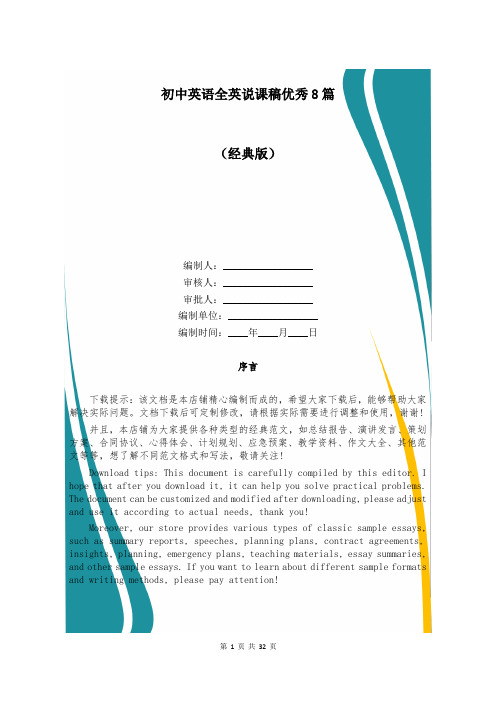
初中英语全英说课稿优秀8篇(经典版)编制人:__________________审核人:__________________审批人:__________________编制单位:__________________编制时间:____年____月____日序言下载提示:该文档是本店铺精心编制而成的,希望大家下载后,能够帮助大家解决实际问题。
文档下载后可定制修改,请根据实际需要进行调整和使用,谢谢!并且,本店铺为大家提供各种类型的经典范文,如总结报告、演讲发言、策划方案、合同协议、心得体会、计划规划、应急预案、教学资料、作文大全、其他范文等等,想了解不同范文格式和写法,敬请关注!Download tips: This document is carefully compiled by this editor. I hope that after you download it, it can help you solve practical problems. The document can be customized and modified after downloading, please adjust and use it according to actual needs, thank you!Moreover, our store provides various types of classic sample essays, such as summary reports, speeches, planning plans, contract agreements, insights, planning, emergency plans, teaching materials, essay summaries, and other sample essays. If you want to learn about different sample formats and writing methods, please pay attention!初中英语全英说课稿优秀8篇说课活动分课前说课和课后说课两种形式,不论是课前说课还是课后说课上述内容必须阐述清楚。
初中英语说课稿全英文

初中英语说课稿全英文Introduction:Good morning, esteemed colleagues. Today, I am excited to share with you my lesson plan for a middle school English class. The lesson is designed to engage students in a variety of activities that will enhance their language skills and foster a love for learning.Objectives:The primary objectives of this lesson are to:1. Improve students' speaking and listening skills through interactive dialogues.2. Enhance their vocabulary by introducing new words in context.3. Develop their reading comprehension through a short story.4. Encourage creative writing by having students write a short paragraph based on the story.Materials:- English textbooks- Whiteboard and markers- Handouts with new vocabulary words- Audio recording of the short story- Writing paper and pencilsProcedure:1. Warm-up (5 minutes)Begin the class with a quick warm-up activity to get students thinking in English. I will ask students to share one thing they did over the weekend, using the present perfect tense.2. Vocabulary Introduction (10 minutes)Introduce new vocabulary words that are relevant to the theme of the lesson. Use flashcards or a PowerPoint presentation to display the words along with their meanings and pronunciation. Engage students in a matching game to reinforce learning.3. Listening Comprehension (15 minutes)Play an audio recording of a short story related to the new vocabulary. Before playing the recording, provide studentswith a list of key questions to listen for. After the first listening, discuss the answers as a class.4. Reading Comprehension (20 minutes)Distribute a printed copy of the short story. Have students read it silently and then answer comprehension questions in small groups. Encourage them to use the new vocabulary wordsin their discussions.5. Speaking Activity (15 minutes)Divide the class into pairs and have them act out a dialogue based on the short story. Each pair should create their own dialogue that includes the new vocabulary words.6. Writing Activity (15 minutes)Instruct students to write a short paragraph from the perspective of one of the characters in the story. Theyshould incorporate the new vocabulary words and express thecharacter's feelings or thoughts.7. Conclusion (5 minutes)Conclude the lesson by reviewing the objectives and summarizing the key points. Ask for volunteers to share their written paragraphs, providing feedback and praise.Assessment:Students will be assessed based on their participation in class activities, their ability to use the new vocabulary correctly, and the quality of their written paragraph.Differentiation:For advanced students, provide more complex sentences to create during the speaking activity. For struggling students, offer additional support with vocabulary and sentence structure during the writing activity.Closure:Thank you for your attention. I am looking forward to implementing this lesson and observing the progress of our students in their English language journey.。
初中英语全英说课稿

初中英语全英说课稿初中英语全英说课稿1Unit13 Rainy days make sad. SectionA (1a-1c)Hello, everyone,Today I’m very pleased to have an opportunity to talk about some of my teaching ideas. My topic is Section A (1a-1c , Grammar Focus) in Unit13 . It is made up of seven parts.1. Analysis textbook(教材分析)2. The teaching methods(教学方法)3. The learning methods(说学法)4. Analysis the students(说学情)5. The procedures of the teaching(教学步骤)6. Blackboard design(板书设计)7. Self evaluation.(自评)Part 1 The analysis of the teaching material:This lesson is about listening and speaking. It plays a very important part in the English teaching of this unit. By studying Section A , The students can improve their speaking ability, learn more about things that affect people. At the same time, we should get the students to understand better. The students should do some listening, speaking and writing, too. Of course, the students should receive some moral education. Let the students have positive attitude to dealing with things around them.1. Teaching objectsThe teaching aims are established according to Junior School English curriculum standard provision.goals1). Words & expressions :tense, some adjectives of feeling2). Key sentences Loud music makes me tense. (P103)Loud music makes me want to dance.That movie made me sad.goalsEnable the students to talk about how things affect them.Emotion & attitude goalsEnable the students to understand the effect of things upon them.The teaching key and difficult points are established according to Section A ,Unit13 in the teaching material’s position and function.2. Teaching Key Pointsthe usage of make.DifficultiesTrain the Ss to use make correctly.To improve students’ listening ability.To train students' municative petence.Part 2. The teaching methodsTask-based teaching; Cooperative learning;Part 3. The learning methods1). Set up six steps. It is presentation– words – pairwork –listening practice–Grammar - practice2). Ask the students to take part in class actively and develop their cooperation in the activities .Part 4. Analysis the studentsThe students have learned some words about feeling and they have know the word make. But they don’t often use English to express themselves and municate with others. Some Ss are not active in the class because they are afraid of making mistakes.Part 5. The procedures of the teachingI have designed the following steps to train their ability of listening, speaking, reading and writing, writing , especially listening and speaking. Set up six steps. It is greeting –lead-in -presentation–words– pairwork – listening practice–Grammar – practice – homework.Step Ⅰ Lead- in.Show the Ss a picture and then show the teaching material.Purpose: Arouse the students’ intere st of study. Bring in new subject: Rainy days make me sad.Step II Presentation.Review some words about feeling , then present the sentence structure.A: What makes him sad?B: Rainy days makes him sad.Purpose :Through this part we can consolidate what they studied yesterday, municate with others about their feelings and prepare for the new lesson.Step III Listening (1a, 1b: P102)Ask the students to listen to Amy and Tina talking about the two restaurants and do the exercises.Purpose :Train the Ss’ listening ability and prepare for later exercises.Step IV Speaking (1c: P102)Ask the students to talk about how music affects them. Let the Ss work in pairs and talk about how the two restaurants would affect them.Purpose :Train the Ss’ speaking ability and prepare for later exercises.Step V Do a survey.After learning 1b , 1c , let the Ss do a survey about other things that affect them.Purpose : This step can open the Ss eyesight and thought . It’s a step from textbook to real life .Step VI Grammar1). Sum the usage of make then help them to say out the sentencestructure.2). Do some exercises to consolidate the grammar.Purpose: Train the Ss’ ability of understanding and using language.Step VII Writing practice4-5 things around you and then describe how the things affect you.Exams make me _______。
初中说课稿模板英语全英文
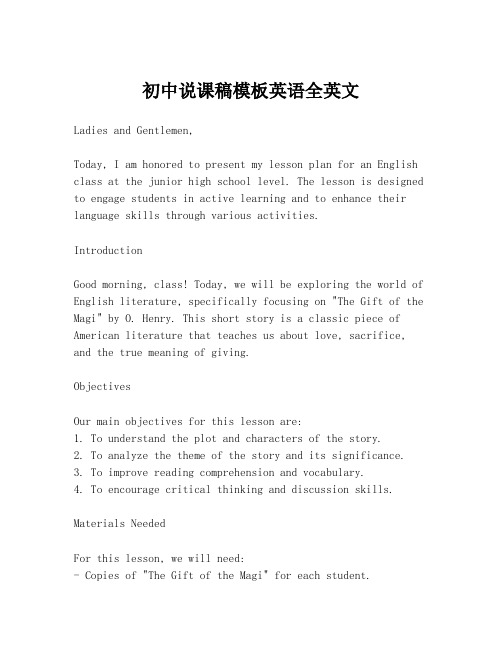
初中说课稿模板英语全英文Ladies and Gentlemen,Today, I am honored to present my lesson plan for an English class at the junior high school level. The lesson is designed to engage students in active learning and to enhance their language skills through various activities.IntroductionGood morning, class! Today, we will be exploring the world of English literature, specifically focusing on "The Gift of the Magi" by O. Henry. This short story is a classic piece of American literature that teaches us about love, sacrifice, and the true meaning of giving.ObjectivesOur main objectives for this lesson are:1. To understand the plot and characters of the story.2. To analyze the theme of the story and its significance.3. To improve reading comprehension and vocabulary.4. To encourage critical thinking and discussion skills.Materials NeededFor this lesson, we will need:- Copies of "The Gift of the Magi" for each student.- Whiteboard and markers.- Handouts with vocabulary words and comprehension questions. - A projector to display images or videos related to the story.Procedure1. Warm-up Activity (5 minutes): We will start with a quick vocabulary match game to review words related to the story. This will set the stage for our reading and discussion.2. Reading (20 minutes): Students will read the story silently, taking notes on the characters, plot, and any unfamiliar words.3. Vocabulary Review (10 minutes): After reading, we will review the vocabulary handout, ensuring that students understand the meaning of new words.4. Comprehension Check (10 minutes): We will go through the comprehension questions to ensure that students have grasped the main ideas of the story.5. Discussion (15 minutes): In pairs or small groups, students will discuss the theme of the story, the sacrifices made by the characters, and what they learned about the value of giving.6. Creative Writing (15 minutes): Students will write a short paragraph or a dialogue inspired by the story, focusing on a similar situation where they had to make a sacrifice forsomeone they cared about.7. Wrap-up (5 minutes): We will conclude the lesson by summarizing the key points discussed and reflecting on the importance of the story's message.AssessmentStudents will be assessed based on their participation in the discussion, the quality of their creative writing, and their understanding of the story's theme and vocabulary.ConclusionIn conclusion, this lesson aims to not only improve students' English language skills but also to impart valuable life lessons through the power of literature. I believe that by the end of this lesson, students will have a deeper appreciation for the story and its underlying message.Thank you for your attention, and I look forward to afruitful and engaging lesson.[End of Lesson Plan]。
完整版)初中英语说课稿(英文版)

完整版)初中英语说课稿(英文版)XXX。
students will XXX XXX.2)技能目标skill objectsXXX' ability to discover。
analyze。
and solve problems。
as well as improve their four language skills。
with a special emphasis on reading。
Students will learn to use Top-down model or Bottom-up model to XXX.3)情感态度目标affective objectsXXX' awareness of environmental issues and XXX them to take n to XXX.二、说教法Teaching methods1.任务型教学task-based teachingThe lesson will be taught using a task-based approach。
where students will be given a task to XXX/reading。
This will help them to apply the language XXX real-XXX.2.交互式教学XXXInteractive teaching methods will be used to XXX group ns。
role-plays。
and XXX.3.多媒体辅助教学multimedia-assisted teachingMultimedia tools such as videos。
pictures。
and online resources will be used to enhance students' understanding of the topic and engage their interest。
完整版)初中英语说课稿全英文版
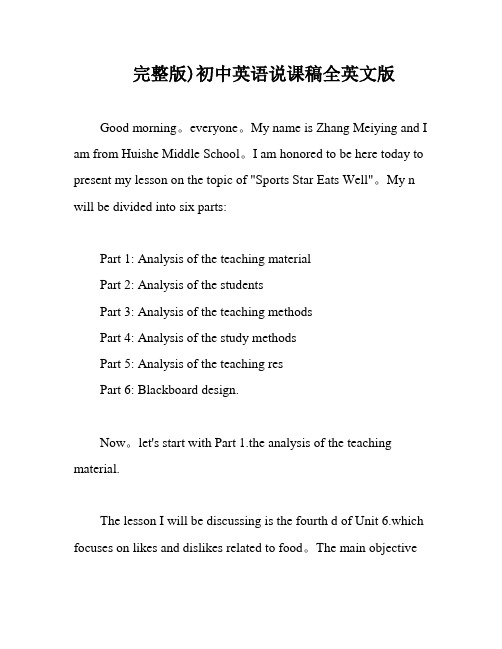
完整版)初中英语说课稿全英文版Good morning。
everyone。
My name is Zhang Meiying and I am from Huishe Middle School。
I am honored to be here today to present my lesson on the topic of "Sports Star Eats Well"。
My n will be divided into six parts:Part 1: Analysis of the teaching materialPart 2: Analysis of the studentsPart 3: Analysis of the teaching methodsPart 4: Analysis of the study methodsPart 5: Analysis of the teaching resPart 6: Blackboard design.Now。
let's start with Part 1.the analysis of the teaching material.The lesson I will be discussing is the fourth d of Unit 6.which focuses on likes and dislikes related to food。
The main objectiveof this lesson is to teach students about the importance of healthy eating habits for sports stars。
To achieve this objective。
we will analyze the following aspects:1.Status and n: The lesson is an integral part of the curriculum and plays a significant role in helping students understand the importance of healthy eating habits for athletes.Let's move on to Part 2.the analysis of the students.Teaching aims and demands include knowledge aims。
- 1、下载文档前请自行甄别文档内容的完整性,平台不提供额外的编辑、内容补充、找答案等附加服务。
- 2、"仅部分预览"的文档,不可在线预览部分如存在完整性等问题,可反馈申请退款(可完整预览的文档不适用该条件!)。
- 3、如文档侵犯您的权益,请联系客服反馈,我们会尽快为您处理(人工客服工作时间:9:00-18:30)。
全英文初中英语说课稿要说好课,就必须写好。
认真拟定说课稿,是说课取得成功的前提,是教师提高业务素质的有效途径。
下面是小编为大家收集的关于全英文初中英语说课稿,欢迎大家阅读!全英文初中英语说课稿Good morning,ladies and gentlemen!I am very pleased to have an opportunity to talk about some of myteaching ideas.The topic of this Unit is “What should I do?” from thetextbook—go for it book 8 unit 2 for junior middle school students.I’d like tosay it from 5 parts as follows:There are teaching materials,teaching methods,learningstrategies,teaching procedures and blackboard design.Now,Let’s come to the first part—Teaching materials.It includestwo parts,status and functions of the material and the teaching content.The thingsin the text book are appropriate to students’ interests,experiencesand knowledge;provide the students with opportunities to use the target languageand stimulate students to seek further information.In unit 2,Studentswill learn to talk about problems and learn to give advice to others.So it ishelpful to improve their communicative competence.Ok,second,teaching content,which includes four aspects,the key vocabulary,the targetlanguage,important and difficult points, and the teaching aims.About theteaching aims,in this unit,students will talk about problems which students come up with intheir daily lives and learn to use modal verbs “could” and “should” to makesuggestions.The second is ability aims,to improve thestudents’ abilities of listening,speaking and readingby providing various tasks.The last is the affection aims,that is,to help eachother and learn to cooperate.Next,let’s come to the second part—teaching methods.Whiledealing with this lesson,I usually adopt “Task\|based” teaching approach.It aims at providing opportunities for the learners to explore bothspoken and written language through learning activities.So,I will letthe students learn in real situations,fulfill severaltasks such as pair work or group work.And in this unit thecommunicative approach and the situational language approach will be adopted.And thefocus is on functional language usage and the ability of learners to expresstheir own ideas,feelings,attitudes,desires and needs.So combine these methods together,enable the studentsto receive,process and retain new information through “multipleintelligences”.Next I’d like to talk about part three—Learning strategies.I usuallytell the students some learning strategies.For four languageskills,I also tell the students to learn efficiently through strategies.Saylistening,in my class I train the students to get the general ideals,makeprediction,make a reference,identify key words and signal words.About theword\|formation and the exploitation are also very important strategies.Each studentcan be involved in the class by using the strategies which are suitable forthem.Ok now,let’s come to the fourth part—Teaching procedures.I’ll finish mylesson in 7 steps,they are Warm up—Lead in—Pre-|task—Task—cycle—Post-task—Homework—Self-assessment.This step-by-step progression allows students to build accuracy andgain confidence with the new language.Step1? Warm upWatch a movie called Let’s Play.The moviewill offer thestudents a relaxing atmosphere and develop students’ interest inEnglish.Step2? Lead inBrainstorming,look at this,funnypicture.He looks very blue and depressed,w hat’ s wrongwith him?What should he do?This brainstorming stage is helpful in providing ideas for actualspeaking.By discussing with peers they can get a lot of informationconcerning the new topic they are going to learn.Step3? Pre-taskIn this step I introduce the topic and give the students clearinstructions on what they will have to do.So first I willprepare some vivid and beautiful pictures to present them the new words.The studentsassociate the meaning of the vocabulary and the form of it,and theyalso practice the speaking and the listening.I’ll get thestudents to do a problem\|solving activity to help the students to recall somelanguage that may be useful for the task.I will make asummary to give a detailed explanation about the Grammar point—sentences tructure “should/could”.I usually try to cultivate the learner’s unconsciouscompetence,give the students more examples.In this way,I think theywill get a further understanding of the Grammar.Step4? Task-cycleTask 1—Pair work.I’ll ask the students to work with their partners to learn to giveadvice to different problems using the key words and the grammatical points.Task 2—Listeningpractice?I designed the (1)Pre-listening activities (2) While-listening activities (3) Post-listeningactivities.Task 3—Group w ork.I’ll get the students act out the conversation in small groups.Step5? Post-taskIn this step,I prepared two activities.First is—Let’sthink.Michael,coming fromUSA.He wants to practice his Putonghua,But he is very shy.So can yougive some advice to him?I suggest that he should get a tutor,can you give more?Make a listof your suggestions.The second is—Discussion.Let’s take a look at the screen,from the picture wecan see the children are studying and living in the very poor condition,1.What’s the matte rwith these children?2.What could they do?3.What should we do? (showing pictures) Put the knowledge into the real situations,elicit thestudents to find out the most efficient ways to the problem in our country.Step6? Homework1.Ask your parentsabout if they have some problems.if they have,Try to give advice.2.Make a survey aboutwho are still in trouble and try to find some solutions.Step7? Self-assessmentIn the process of teaching and learning,teachersneed to know what has been done well and what needs to be improved further;where thestudents perform well and where they still feel confused.Thediversities of classroom activities,and a welcoming andengaging learning environment will make the study easy and happy.Thus thestudents will get more experience and exploitation by doing things.And the last Part is Blackboard design? I’ll write thenew words on the left,on the right I write the target language.If possibleI’ll draw some pictures.It is terseness and easy to understand.Thank you for listening,goodbye!。
